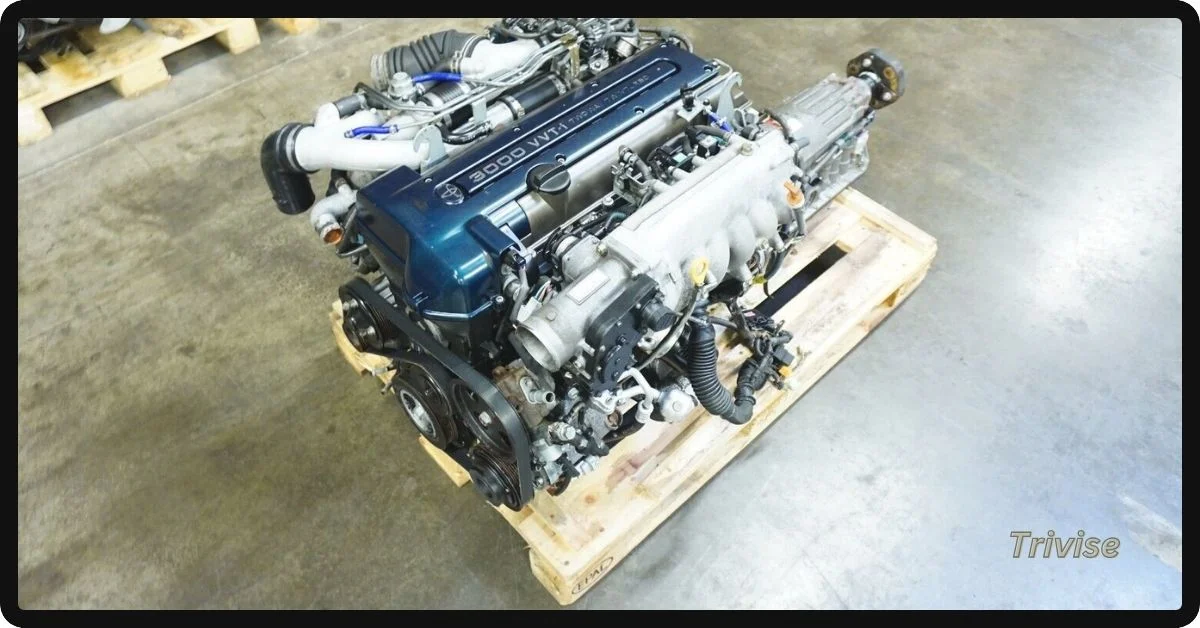The 2JZ engine, one of Toyota’s most iconic and revered powerplants, has captured the hearts of car enthusiasts, tuners, and performance drivers worldwide. Known for its incredible strength, reliability, and tuning potential, the 2JZ has earned its reputation as one of the most durable and performance-oriented engines ever built. This article explores the 2JZ engine, its history, variations, key features, and what to look for when buying a 2JZ engine for sale.
Whether you’re a car enthusiast looking to upgrade your build or a mechanic seeking the perfect engine for a project car, understanding the 2JZ and its potential will help you make an informed decision. So, let’s dive into what makes the 2JZ engine so special, why it has maintained its popularity for decades, and what you need to know when buying one.
What is the 2JZ Engine?
The 2JZ engine is a series of inline-six engines produced by Toyota. It’s renowned for its exceptional strength, high-performance potential, and versatility. The 2JZ was introduced as part of the JZ engine family, which also includes the 1JZ, 3JZ, and 5JZ engines. The 2JZ series was designed to be a durable and reliable powerplant capable of handling high-performance tuning and aftermarket modifications.
There are two main versions of the 2JZ engine:
- 2JZ-GE (Naturally Aspirated): The naturally aspirated version, the 2JZ-GE, was designed for everyday use and delivers solid performance for a non-turbocharged engine. It offers a strong foundation for tuners who want a reliable engine that can be built upon.
- 2JZ-GTE (Turbocharged): The 2JZ-GTE, the turbocharged variant of the 2JZ engine, became famous due to its association with the Toyota Supra Mark IV (A80), one of the most legendary performance cars in automotive history. The turbocharged version offers immense power potential and is known for being able to handle substantial amounts of boost without compromising reliability.
History of the 2JZ Engine
The 2JZ engine was introduced in 1991 as a successor to the 1JZ engine, which had already established Toyota’s reputation for producing durable, high-performance inline-six engines. The 2JZ series was a part of the Toyota Supra project, and the 2JZ-GTE engine, in particular, found a home in the fourth-generation Toyota Supra A80, which was produced from 1993 to 2002.
In the 1990s, Toyota was competing with performance models from manufacturers like Nissan and Mitsubishi, who were producing some of the most technologically advanced cars in the world. The 2JZ-GTE engine helped give the Supra its legendary status, offering 280 horsepower and 318 lb-ft of torque in its stock form, with potential for far more with aftermarket modifications.
The 2JZ engine was designed with durability in mind. Its solid iron block, robust internals, and high-flow cylinder head made it the perfect platform for tuning. Enthusiasts quickly began to push the limits of the 2JZ-GTE, building cars that produced over 1,000 horsepower with relative ease. This made the engine a favorite among drag racers, street racers, and performance enthusiasts who valued both power and reliability.
Key Features of the 2JZ Engine
What sets the 2JZ apart from other engines is its robust design and inherent ability to handle high power outputs. Here are some of the key features that make the 2JZ engine such a highly regarded piece of engineering:
1. Strong Engine Block
The 2JZ engine block is made of cast iron, which gives it a significant strength advantage over many other production engine blocks made from aluminum. This strength allows the engine to handle extreme amounts of power and boost without fear of cracking or warping, which is why it’s a favorite in high-performance builds.
2. Robust Internals
The internals of the 2JZ engine are built to last. The engine features forged steel crankshafts and high-strength pistons, which are able to withstand the stresses of forced induction and high-revving applications. This robustness means the engine can take a beating and keep running, even when producing significantly more power than it was originally designed for.
3. Excellent Tuning Potential
One of the most appealing aspects of the 2JZ engine is its tuning potential. Whether you have a naturally aspirated 2JZ-GE or a turbocharged 2JZ-GTE, the engine responds well to modifications. With upgrades like bigger turbos, stronger fuel systems, and engine management systems, the 2JZ can easily reach levels of power that many other engines can’t handle. This has made the 2JZ an icon in the tuning world.
4. Advanced Fuel System
The 2JZ-GTE is equipped with a sequential twin-turbo system, which provides smoother power delivery and better performance at both low and high RPMs. The multi-port fuel injection system ensures that the engine is provided with the precise amount of fuel for efficient combustion.
5. Overbuilt Head and Valve Train
The 2JZ’s cylinder head features DOHC (Dual Overhead Cam) and 24 valves, which helps it achieve high power outputs. The engine’s VVT-i (Variable Valve Timing) system also allows for better fuel efficiency and performance across different RPM ranges. The valve train is designed to handle high revs, making the 2JZ engine perfect for high-performance builds that require sustained high RPM operation.
Different Versions of the 2JZ Engine
There are several versions of the 2JZ engine, and the most commonly available in the market are the 2JZ-GE and the 2JZ-GTE.
2JZ-GE (Naturally Aspirated)
The 2JZ-GE is the naturally aspirated version of the 2JZ engine. It’s still a very capable engine, providing 220-230 horsepower depending on the application. The 2JZ-GE is often found in cars like the Toyota Aristo and the Lexus IS300, and it is known for its smooth power delivery, reliability, and durability.
Though it lacks the boost of the turbocharged 2JZ-GTE, the 2JZ-GE is a popular choice for enthusiasts looking to build a reliable engine that can handle forced induction or just provide a solid foundation for other performance upgrades. The 2JZ-GE is ideal for NA-turbo swaps, where the engine is modified to accept a turbocharger.
2JZ-GTE (Turbocharged)
The 2JZ-GTE is the turbocharged version of the 2JZ, which became famous through its use in the Toyota Supra A80. This engine produces around 280 horsepower in stock form, but it has the potential for much more with the right modifications. The 2JZ-GTE is often used in motorsports, drag racing, and high-performance street builds, as it can easily handle modifications that increase power into the four-digit range.
The 2JZ-GTE features a twin-turbo setup, where two smaller turbos work in parallel to provide both fast spool times and higher power potential. The engine is also equipped with oil squirters to cool the pistons, and a stronger crankshaft compared to the naturally aspirated version.
Buying a 2JZ Engine for Sale
When looking for a 2JZ engine for sale, there are several factors to consider. Whether you’re buying a used engine for a project car, a replacement engine for your Toyota Supra, or a high-performance build, here are some tips for ensuring you get the best deal and a quality engine.
1. Buy from a Reputable Seller
One of the most important things to look for when purchasing a 2JZ engine is a reputable seller. You can find 2JZ engines at performance parts shops, junkyards, or through online marketplaces. Make sure the seller is trustworthy and provides clear details about the engine’s condition. Ask for compression tests, any history of modifications, and maintenance records.
2. Engine Condition
Check the engine’s overall condition. Whether you’re buying a used 2JZ-GE or a 2JZ-GTE, you want to ensure the engine is in good shape. Look for signs of wear and tear, oil leaks, rust, or any unusual damage to the block. It’s also a good idea to ask for a compression test or leak-down test to check the engine’s internals.
3. Verify the Engine’s Origin
Some 2JZ engines are imported from Japan, and it’s important to verify the engine’s origin. Import engines, especially those from Japan’s JDM (Japanese Domestic Market), can often have low mileage and a relatively well-maintained history. However, be cautious of engines that have been tampered with or modified without clear documentation.
4. Budget for Additional Parts
When purchasing a 2JZ engine, you may need additional components to complete the build. This can include a new turbo kit, fuel system, intercooler, or ECU. Ensure you budget for these additional parts, as they can add significant cost to the project.
Conclusion: The Legacy of the 2JZ Engine
The 2JZ engine continues to be a symbol of Toyota’s commitment to performance and engineering excellence. With its rock-solid build quality, incredible tuning potential, and legendary reputation, the 2JZ-GTE (and its naturally aspirated counterpart, the 2JZ-GE) remains a top choice for enthusiasts looking to build high-performance, reliable, and powerful engines. Whether you are restoring a classic Toyota Supra or building a custom project car, the 2JZ engine is an excellent choice that offers tremendous value for both street builds and racing applications.
If you’re looking for a 2JZ engine for sale, make sure to do your research and find a reputable seller. Ensure the engine is in good condition, and remember that additional parts may be required to complete the engine swap or upgrade. With the right approach, the 2JZ engine can serve as the foundation for a truly legendary build that will stand the test of time.
FAQs About the 2JZ Engine
- What makes the 2JZ engine so popular? The 2JZ engine is popular because of its reliability, tuning potential, and ability to handle high amounts of horsepower. The turbocharged 2JZ-GTE is especially known for its strong internals, which allow it to easily support major performance upgrades.
- Where can I find a 2JZ engine for sale? You can find 2JZ engines for sale from reputable sellers, JDM importers, online marketplaces, performance parts shops, and even salvage yards. Make sure to research the engine’s history and condition before making a purchase.
- What is the difference between the 2JZ-GE and 2JZ-GTE? The 2JZ-GE is the naturally aspirated version, while the 2JZ-GTE is turbocharged. The 2JZ-GTE offers more power and is better suited for high-performance applications, while the 2JZ-GE is a solid choice for naturally aspirated builds.
- How much power can the 2JZ engine handle? The 2JZ engine is known for handling high power outputs. The stock 2JZ-GTE can handle up to 500 horsepower reliably, but with aftermarket modifications, it has been known to support over 1,000 horsepower.
- What are the common problems with the 2JZ engine? The 2JZ engine is highly reliable, but common issues can include oil leaks, worn-out gaskets, or turbo failure (on the 2JZ-GTE). Regular maintenance and proper care can help avoid these problems.
- Can I swap a 2JZ engine into my car? Yes, many car enthusiasts perform 2JZ engine swaps, especially into older Toyota models like the Toyota Supra. However, keep in mind that the swap can require modifications to the engine bay, transmission, and other systems depending on the car.









